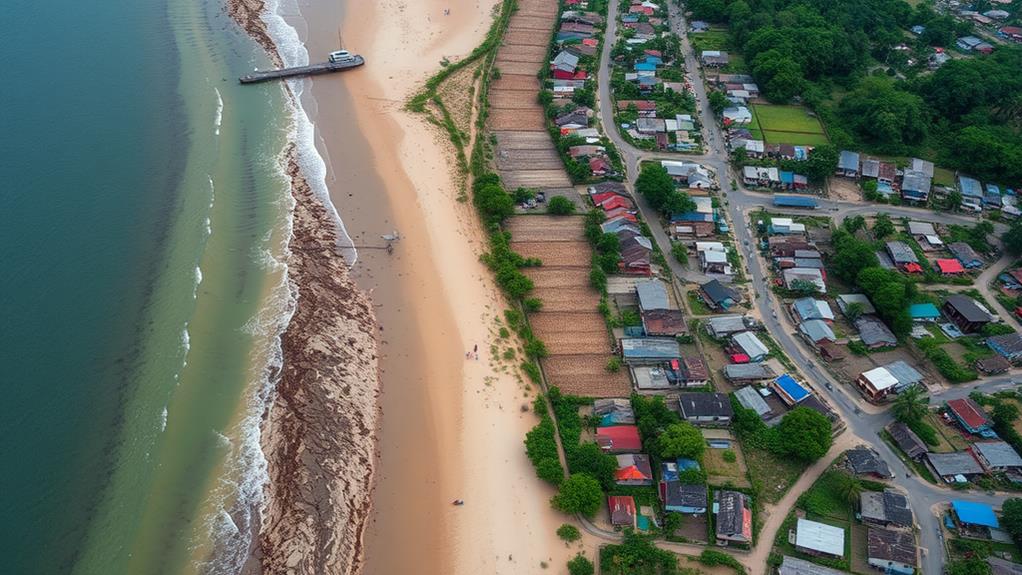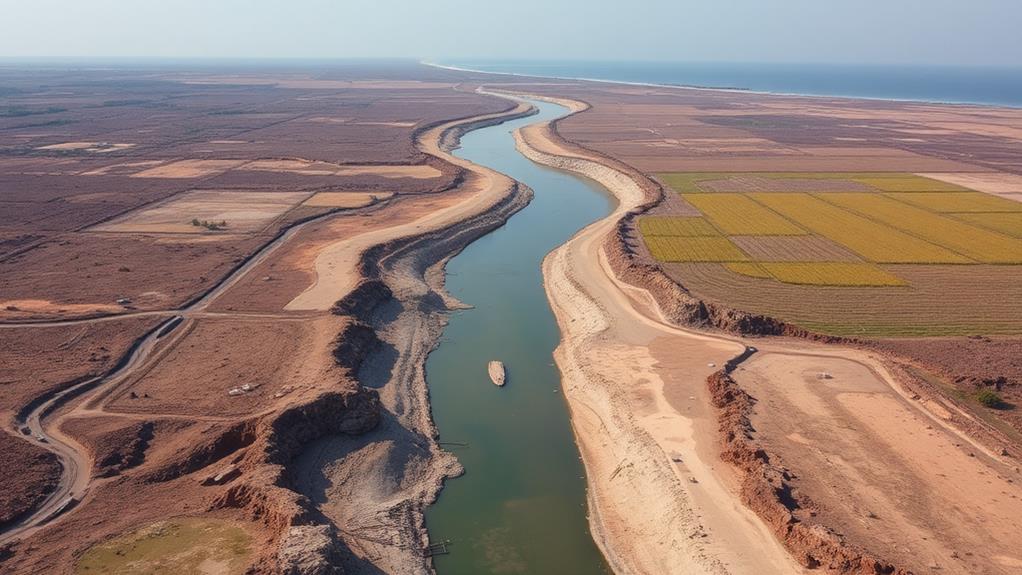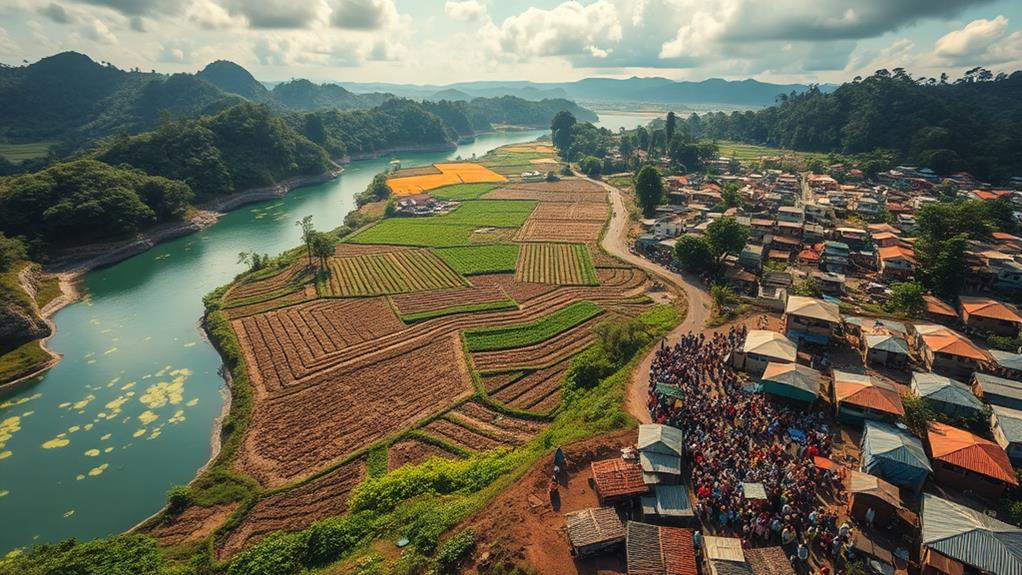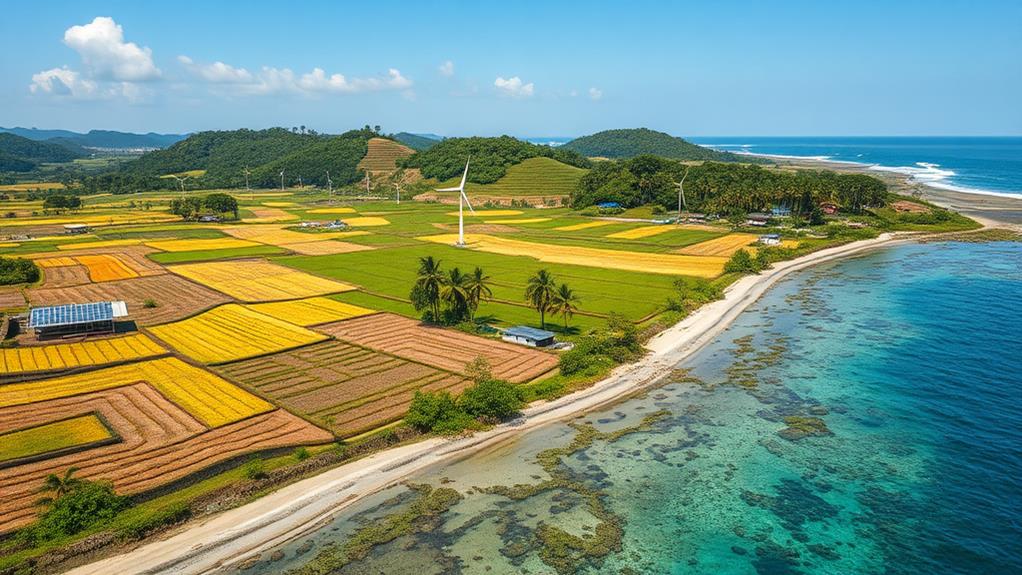Climate change has a major effect on natural resources and industries in the Philippines.
Agriculture is declining, with rice yields expected to drop by 10% for every 1°C rise in temperature. This means that farmers will produce less rice, which is a staple food for many.
Fisheries are also at risk, with potential fish catches decreasing by 50%. This threatens the livelihoods of many families who depend on fishing.
Water scarcity is another issue, making it harder for farmers to irrigate their crops. This can lead to lower food production and higher prices for consumers.
Experts predict that the economy could lose up to 13.6% of its GDP by 2040, which could worsen poverty for many people.
Vulnerable groups, particularly women and indigenous communities, face greater risks from these changes.
Adaptation strategies, such as using new farming techniques or protecting natural habitats, can help reduce these impacts.
However, understanding the overall situation reveals more challenges and potential solutions ahead.
Overview of Climate Vulnerability

Climate vulnerability in the Philippines is a serious issue. The country is the third most vulnerable to climate change, facing threats from natural disasters such as cyclones, landslides, floods, and droughts.
About 60% of the population lives in coastal areas, making them more at risk due to rising sea levels and extreme weather.
The economy relies heavily on natural resources that are affected by climate change. Agriculture, forestry, and fisheries are important for both the economy and food security.
Certain groups, like women and indigenous communities, face even greater risks that can harm their financial stability.
Action is urgent because climate change could lead to a GDP reduction of up to 13.6% by 2040 if no steps are taken.
Without proactive measures, the effects of climate change will worsen existing problems. It's crucial for both communities and leaders to focus on sustainable practices and protect natural resources.
Impacts on Agriculture and Fisheries
Natural resources, especially agriculture and fisheries, are heavily affected by climate change in the Philippines. These impacts threaten food security and the livelihoods of many people. Here are the main issues:
In agriculture, rising temperatures and changing rainfall patterns are leading to reduced crop yields and increased pest and disease infestations. In the fisheries sector, warming seawater and ocean acidification are causing disruptions in fish habitats and spawning grounds. These challenges have significant implications for economic growth and social equity, as many people in the Philippines rely on agriculture and fisheries for their livelihoods and food security. Addressing these issues is crucial for ensuring the sustainability of these natural resources and the well-being of the communities that depend on them.
- Production Losses: Agriculture employs 30% of the workforce and contributes 10% to GDP. This sector is very vulnerable to natural disasters and extreme weather, which can cause significant production losses.
- Yield Declines: Rising temperatures are expected to cause a 10% decrease in rice yields for every 1°C increase. This decline threatens the availability of staple foods.
- Fisheries Decline: The fisheries sector, which employs 1.4 million people, may see a 50% decline in fish catch potential due to climate change and overfishing. This situation puts many livelihoods at risk.
- Economic Instability: By 2100, the economy may face a 6% annual GDP loss. This loss threatens the financial stability of farming communities and can worsen food shortages.
Changes in Water Resources

Water resources in the Philippines are facing serious challenges due to environmental changes. By 2040, the country is expected to experience increased water scarcity, ranking 57th in global water stress. The main reasons for this crisis are rapid urbanization and population growth.
According to PAGASA, changes in rainfall patterns are predicted, with most regions experiencing less rainfall, which could harm both farming and water supply.
The agriculture sector is likely to be the hardest hit by these water shortages. This can lead to problems like food insecurity and affect the livelihoods of farmers. For example, as water becomes scarcer, farmers might find it hard to irrigate their crops. This could lead to lower crop yields and higher food prices.
Additionally, the sea level rise in the Philippines has reached 60 cm, which is three times higher than the global average. This poses a risk of displacement for 60% of local government units, making it harder for vulnerable communities.
Climate change is making these issues worse by causing more frequent droughts and typhoons, which disrupt both the availability and quality of water. This mix of challenges threatens not only water resources but also the sustainability of livelihoods and food security throughout the country.
Threats to Biodiversity
Biodiversity in the Philippines is seriously threatened by climate change. As temperatures increase, ecosystems are at risk, which can harm both wildlife and people. Here are some major threats:
- Coral Reefs: By 2050, 98% of coral reefs in Southeast Asia, including the Philippines, may die due to rising sea temperatures and ocean acidification. This loss will threaten marine biodiversity.
- Grasslands: About 1 million hectares of grasslands are at risk from climate change. Prolonged dry periods can lead to more fires and habitat destruction, making it harder for plants and animals to survive.
- Fish Stocks: The amount of fish caught in Philippine waters could decline by 50%, which threatens the food supply for communities that depend on fishing.
- Rice Production: For every 1°C increase in temperature, rice yields could drop by 10%. This is a major concern for a nation that relies heavily on rice for food.
These climate change impacts worsen natural disasters and increase risks for vulnerable groups, especially indigenous communities that rely on biodiversity for their livelihoods.
It's essential to address these threats for sustainable development and ecological balance.
Public Health Implications

Climate change significantly affects public health in the Philippines. Higher temperatures lead to more cases of diseases such as dengue and malaria. For example, during the 1998 El Niño event, there were 40,000 cases of dengue and 1,200 cases of cholera reported across the country.
As climate change continues, it's expected to decrease labor productivity by 4% by 2085 because of increased heat, which will put more pressure on health systems.
Vulnerable populations, particularly women, are at greater risk during climate events, making existing health issues worse. Changes in rainfall and rising temperatures promote the spread of vector-borne diseases and create food insecurity.
These challenges not only impact individual health but also strain healthcare resources.
The Philippines is prone to natural disasters, which makes it essential to develop strong public health strategies for adaptation. Improving community resilience and reducing health risks from climate change can help protect public health.
Addressing these issues now is vital for ensuring a healthier future for all.
Economic Consequences
Climate change presents serious economic problems for the Philippines. Without proper actions, the country's GDP could drop by up to 13.6% by 2040. This decline could harm not only the economy but also the jobs and lives of many people.
- Agricultural productivity: Changes in rainfall and higher temperatures could lower rice production by 10% for every 1°C increase, which threatens food security for the nation.
- Fisheries sector: Climate change may cause fish catches to decrease by 50%, impacting 1.4 million workers and reducing important protein sources for many families.
- Water scarcity: By 2040, the Philippines could become the 57th most water-stressed country in the world. This would greatly hurt farming and make economic issues worse.
- Emergence of the "new poor": If GDP losses reach about 6% per year by 2100, more people in vulnerable communities could fall into poverty, risking social stability.
The link between greenhouse gas emissions and the depletion of natural resources shows the urgent need for climate adaptation plans. Tackling these economic challenges is crucial for sustainable growth and building resilience against climate change.
Strategies for Adaptation and Resilience

The Philippines needs to create strategies for adaptation and resilience to fight climate change. Investing 0.5% of GDP in adaptation strategies by 2020 could prevent a loss of 4% of GDP by 2100 due to climate impacts. For example, disaster-resilient agricultural practices can help protect crops and livestock from extreme weather.
Using nature-based solutions can improve climate resilience and offer economic benefits. For instance, restoring mangroves can protect coastlines while supporting fisheries. Working with the private sector is also important. Initiatives like energy efficiency programs and developing compact cities can lower emissions and strengthen urban areas.
Here's a summary of these strategies:
| Strategies | Benefits |
|---|---|
| Disaster-resilient agriculture | Protects crops and livestock |
| Nature-based solutions | Boosts biodiversity and ecosystems |
| Private sector collaboration | Encourages innovation and investment |
Questions and Answers
What Is the Impact of Climate Change in the Philippines?
Climate change in the Philippines causes coastal erosion, which damages shorelines and homes. For example, rising sea levels lead to the loss of land in coastal areas. It also threatens agricultural productivity, making it harder for farmers to grow crops. For instance, changing weather patterns can result in droughts or floods, impacting food supply.
Additionally, climate change leads to biodiversity loss. Many plant and animal species are at risk as their habitats are altered or destroyed. Furthermore, there is an increase in extreme weather events such as typhoons and heavy rainfall, causing destruction and displacement.
These environmental issues contribute to health risks for communities. For example, polluted water and poor air quality can lead to illnesses. Economic instability also occurs as livelihoods are affected, especially in agriculture and fishing. Overall, climate change significantly impacts the lives of people in the Philippines.
How Does Climate Change Affect Livelihood in the Philippines?
Climate change threatens fishing and farming in the Philippines. This change can reduce the number of fish available and lower crop yields, which affects food security and jobs in rural areas. For example, if ocean temperatures rise, fish may migrate to cooler waters, making them harder to catch. Similarly, droughts or heavy rains can ruin crops, leading to less food and income for farmers.
Coastal communities are especially at risk from natural disasters like typhoons and flooding. These events can cause significant economic losses and damage homes and businesses. To combat this, it is important for these communities to build strong disaster resilience. This means preparing better for disasters to protect their livelihoods and ensure a more sustainable future.
How Does Climate Change Affect the Philippines' Water Resources?
Climate change causes water scarcity in the Philippines. This means there is less water available for drinking and farming. For example, the country is experiencing more frequent droughts, which dry up rivers and lakes. Flooding patterns are also changing. Heavy rains can lead to floods that damage homes and crops.
Water quality is declining due to groundwater depletion. This happens when too much water is taken from underground sources faster than it can be replaced. For instance, in some areas, the water is becoming salty or polluted, making it unsafe to drink. Reservoir management is becoming more complicated. This is because it is harder to ensure there is enough clean water for everyone.
These changes threaten sustainable access to clean water. Without proper management, many people may struggle to find safe drinking water in the future.
How Does Climate Change Affect Natural Resources?
Climate change reduces agricultural productivity. For example, rising temperatures can lead to droughts, which make it harder for crops to grow. Additionally, it causes soil erosion. Heavy rainfall can wash away topsoil, making land less fertile. Furthermore, climate change leads to forest degradation. Increased temperatures and pests can damage trees, reducing forest health. As a result, there is biodiversity loss. Many plant and animal species are struggling to survive in changing climates. Lastly, climate change threatens fisheries sustainability. Warmer waters can disrupt fish populations and their migration patterns. Overall, these effects compromise essential ecosystem services like clean air and water, which are crucial for human life and economic stability.